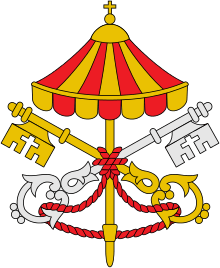Papal selection before 1059

There was no fixed process for papal selection before 1059. Popes, the bishops of Rome and the leaders of the Catholic Church, were often appointed by their predecessors or secular rulers. While the process was often characterized by some capacity of election, an election with the meaningful participation of the laity was the exception to the rule, especially as the popes' claims to temporal power solidified into the Papal States. The practice of papal appointment during this period would later give rise to the jus exclusivae, a veto right exercised by Catholic monarchies into the twentieth century.
The lack of an institutionalized process for papal succession was prone to religious schism, and many papal claimants before 1059 are currently regarded by the Church as antipopes, although most are not. Furthermore, the frequent requirement of secular approval of elected popes significantly lengthened periods of sede vacante and weakened the papacy. In 1059, Pope Nicholas II succeeded in limiting future papal electors to the cardinals with In Nomine Domini, creating standardized papal elections that would eventually evolve into the papal conclave.
During the Roman Empire
From Peter to Fabian (64/67–236)
There is no scholarly consensus on when and on what terms Saint Peter arrived in Rome, but most agree that he died there in 64 or 67.[1] Moreover, Peter was never contemporaneously referred to as a "pope" or even a "bishop".[1] Unlike the selection process for a deacon, which is outlined in Acts 6:1-6, there is no biblical method for the selection of a bishop other than by simple apostolic appointment;[2] the earliest text mentioning the election of a bishop is Teaching of the Twelve Apostles circa 100 AD/CE.[3][4]
Although the election of bishops in other early Christian communities is often described in contemporary sources, the earliest Roman sources date from 400, claiming that Peter himself appointed Linus, Anacletus, and Clement—in that order—as his successors.[4] The early official lists of Bishops of Rome are considered problematic by scholars because of their bias towards enhancing papal authority and anachronistically imposing continuity; for example, the earliest, the Liber Pontificalis, dating probably from 354, is notoriously unreliable for the first two centuries.[4]
Recorded public elections (236–492)

Eusebius of Caesarea relates a legend of the election of Fabian in 236: a dove landed on Fabian's head and "thereupon the people, all as if impelled by one divine spirit, with one united and eager voice cried out that he was worthy, and immediately they set him on the episcopal seat".[5][4] This anecdote makes clear that "the choice of bishop was the public concern for the entire Christian community of Rome".[4] Fabian can reliably be regarded as a victim of the persecution of Emperor Decius, after which there was no election for fourteen months.[4]
The next available evidence comes from the schism between Novatian and Cornelius, both elected bishop by their own factions, and both writing to Cyprian, bishop of Carthage for support.[6] Cyprian sided with Cornelius, writing that:
Moreover, Cornelius was made bishop by the choice of God and of His Christ, by the favorable witness of almost all of the clergy, by the votes of the laity then present, and by the assembly of bishops.[6]
Cyprian also remarks that Cornelius had been ordained by sixteen bishops from the surrounding region, while Novatian had only been ordained by three, the first definite evidence of a true schism in the Roman church.[6]
Mark was the first to designate the bishop of Ostia as the first among the consecrators of the new bishop of Rome (the bishop of Ostia is currently the Dean of the College of Cardinals).[7] However, the influence of Emperor Constantine I, a contemporary of Sylvester I and Mark, would help solidify a strong role for the Roman emperor in the selection process: Constantine chose Julius I for all intents and purposes, and his son Constantius II exiled Liberius and installed Felix II (an Arian) as his successor.[7] Felix and Liberius were succeeded in schism by Ursinus and Damasus, respectively, the latter of whom managed to prevail by sheer bloodshed, and he is the first bishop of Rome who can non-anachronistically be referred to as a "Pope" (παππας, or pappas).[7] Damasus persuaded the Emperor to decree him "bishop of bishops", a claim that severely antagonized Eastern bishops, leading to the First Council of Constantinople in 381, which dealt in part with the issue of supremacy.[8]
Even with this new title, however, the method of selection of the bishop of Rome remained much the same. Both the clergy and the laity continued to participate in the selection, along with local and imperial politics.[8] Other trends can be observed, as well, such as father-to-son succession between Pope Anastasius I and Pope Innocent I.[8] Emperor Honorius stepped in to resolve the schism between Eulalius and Pope Boniface I (both elected), siding with Eulalius first and then Boniface I.[9] Honorius decreed that any future schisms should be decided by unanimous selection; although this decree has never been employed in resolving a disputed papal election, it indicates the increasing degree of imperial interest in the question of papal succession.[9]
Odoacer
Elections of the same manner continued largely undisputed until Pope Simplicius, who was terminally ill for enough of his papacy to devote time to succession issues, who decreed that the minister of Germanic general Odoacer, a Roman nobleman, would have the power of approval over his successor (there was no longer a western Roman emperor, Romulus Augustulus having been deposed in 476): the result was Pope Felix III, the first patrician pope.[9]
Ostrogothic rule (493–537)

The next electoral schism of note developed between Symmachus and Laurentius, who both appealed to Theodoric the Great, the Ostrogoth king of Italy (and an Arian); the result is the first documented case of papal simony, wherein both candidates attempted to bribe the royal councilors, if not Theodoric himself, to influence his choice; Theodoric sided with Symmachus who proceeded to decree that reigning bishops would be able to designate their own successors, ending the participation of the laity for at least a half-century.[10]
This process was used without serious issue until the death of Pope Felix IV, who had given his pallium to Pope Boniface II on his deathbed in 530 and decreed excommunication of any who refused to accept the succession.[10] The Roman Senate disliked the lack of election and denounced Felix, affirming a decree of Pope Anastasius II, which had prohibited the practice of a pope designating a successor.[10] Boniface II was supported only by a minority of the clergy, with the larger share supporting Dioscorus, with only Dioscorus's death halting the schism.[10]
Boniface II attempted to re-entrench the practice of appointing his successor, but the public outcry was too great, resulting in a highly disputed election in 532 characterized by widespread accounts of bribery and coercion, which resulted in Pope John II (the first to take a papal name).[11] Athalaric, the Ostrogoth king, forced John II to approve decrees that banned any private agreements to elect a pope and enacting limits on the amount of money that could be spent during a papal election (an early example of campaign finance reform).[11] In fact, Athalaric himself was able to engineer the election of Pope Silverius, the son of Pope Hormisdas, upon John II's death.[11]
Byzantine influence (537–752)

Upon his invasion of Italy, Justinian I forced Silverius to abdicate and in his place installed Pope Vigilius, a former papal legate to Constantinople. Justinian next appointed Pope Pelagius I, holding only a "sham election" to replace Vigilius. Afterwards, Justinian was content with power of approval of the pope, as with Pope John III after his election.[11] Justinian's successors continued this practice for over a century.[11]
The continuing power of appointment of the Byzantine emperor can be seen in the legend of Pope Gregory I writing to Constantinople, asking them to refuse his election.[11] Pope Boniface III issued a decree denouncing bribery in papal elections and forbidding discussion of candidates for three days after the funeral of the previous pope; thereafter, Boniface III decreed that the clergy and the "sons of the Church" (i.e. nobles) should meet to elect a successor, each voting according to their conscience.[12] This abated factionalism for the next four successions, each resulting in quick elections and imperial approval.[12] However, Pope Severinus was forced to wait 20 months for imperial approval in 640, receiving it only months before his death. So Pope Martin I refused to wait, insisting on being consecrated only days after his election. This resulted in his abduction by Constans II to Constantinople in 653, where he was tried and sentenced to exile.[12] The next seven popes were more agreeable to Constantinople, and approved without delay, but Pope Benedict II had to wait a year in 684. After that, the emperor delegated the approval to the Exarch of Ravenna, the Byzantine governor of central Italy, including the Duchy of Rome.[12]
During the pontificate of Pope Benedict II (684-685), Constantine IV waived the requirement of imperial approval for consecration as pope, recognizing the sea change in the demographics of the city and its clergy.[13] Benedict II's successor Pope John V was elected "by the general population", returning to the "ancient practice".[13] The ten Greek successors of Agatho were likely the intended result of Constantine IV's concession.[14] The elections of this period are known to have been held in the Basilica of St. John Lateran (with the possessor of the Lateran likely to prevail in the event of schism), but the exact participants in the elections are not known with certainty.[15] Lay participation likely still occurred, but the basilica itself was too small for the phrase "with the whole people" to continue to be literal.[15]
The Roman army (controlled by local aristocrats) entered papal politics in 686 by seizing the Lateran upon the death of Pope John V and evicting the clergy, violently forcing the consecration of Pope Conon and Pope Sergius I.[15] The next two elections were also controlled by the army, but with less overt violence.[15] Pope Zachary, in 741, was the last pope to announce his election to a Byzantine ruler or seek their approval.[15]
Frankish influence (756–857)
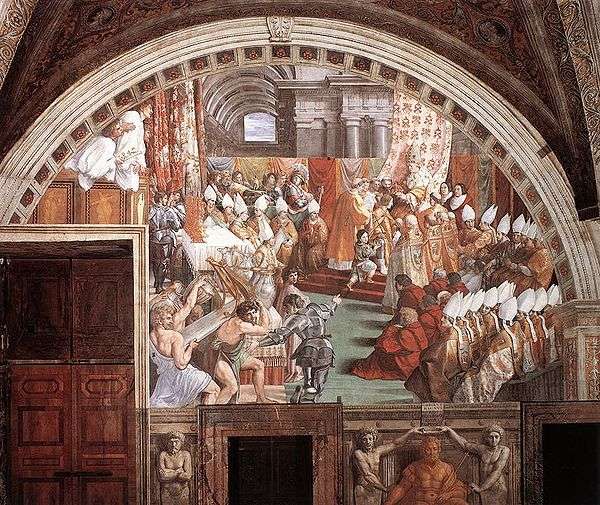
Pope Stephen II crossed the Alps to appeal for the aid of Pepin the Short upon his election in 752, following the Lombard takeover of Ravenna, resulting in the Donation of Pepin which strengthened the claim of the popes to the de facto Papal States, and thus the incentives for secular interference in papal selection.[16] The death of Stephen II's brother and successor Pope Paul I was followed by a bloody schism characterized by Toto of Nepi and Pope Stephen III; after Toto had his eyes gouged out and was imprisoned, Stephen III decreed that the entire Roman clergy had the right to elect the pope but restricted eligibility for election to the cardinal-priests and cardinal-deacons (incidentally, the first use of the term "cardinals" to refer to the priests of the titular churches or the seven deacons); the cardinal-bishops, supporters of Toto, were excluded.[16] Of course, the Roman laity quickly regained its role after Stephen III's decree, and maintained its participation until 1059.[16]
Pope Adrian I and Pope Leo III were elected under the rules of Stephen III, but the latter was forced from Rome and sought the aid of Charlemagne.[17] After two unanimous elections, Charlemagne's son Louis the Pious intervened in a bitterly disputed election in favor of Pope Eugene II.[17] Thereafter the process was returned by apostolic constitution to the status quo circa 769, reincorporating the lay Roman nobles (who continued to dominate the process for 200 years) and requiring the pope to swear loyalty to the Frankish ruler.[17] The consecration of Pope Gregory IV was delayed for six months to attain the assent of Louis.[17]
When the clergy and the nobles elected different candidates in 844, Emperor Lothair I sided with Pope Sergius II, the noble candidate; three years later Pope Leo IV was consecrated without imperial approval, which would have been difficult in any case as the Carolingian Empire was in the process of breaking up.[17] Lothair II of Lotharingia indeed failed to impose his own candidate, Pope Benedict III, in 855 until the Roman-elected candidate refused the office (the first recorded historical refusal).[18] Lothair II was present for the election of Pope Nicholas I, who prohibited anyone outside of the Roman community from interfering in papal elections, and as a result Pope Adrian II was consecrated without even informing the Franks.[18]
Pornocracy (904–963)
The assassination of Pope John VIII inaugurated a period marked by short papal reigns, in which as many as twelve popes were killed (sometimes after resignation), three more deposed, and two abdicated—a period known to historians as the "pornocracy" (Greek, rule of the harlots) or saeculum obscurum (Latin, the dark age).[18] Following the alliance of Pope Sergius III with Theophylact I, Count of Tusculum (the father of Marozia, Sergius III's son's mother) and his wife Theodora, Theophylact succeeded in creating four of the next five popes.[19] The son of Sergius III and Marozia reached the papacy as Pope John XI, only to be deposed by King Alberic II of Spoleto, who was able to control the installation of the next four popes, eventually installing his own son Pope John XII, whose main act was to crown Otto I as Holy Roman Emperor.[19]
A synod in 963 deposed John XII and elected Pope Leo VIII (963-965), but the Romans would not accept him once his protector, Otto I, departed, prompting the election of Pope Benedict V (964).[19] Otto I would further succeed in appointing Pope John XIII (965-972) and Pope Benedict VI (973-974).[20]
Crescentii era (974–1012)
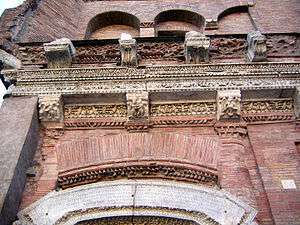
Otto I's successor, Otto II, was impelled to take over Rome by force in 980 to depose Antipope Boniface VII and install his preferred candidate Pope John XIV (983-984), without even feigning an election.[20]
Pope John XV, the candidate of the Roman nobles upon the death of Otto II, did not survive long enough to be deposed by Otto III, who engineered the election of Pope Gregory V upon reaching Rome in 996.[20] However, Gregory V could not remain on the throne once Otto III headed back for Germany, and the Romans replaced him with Antipope John XVI temporarily until Otto III could return.[20] Otto III reinstalled Gregory V and secured the election of Pope Sylvester II (999-1003) upon his death, only to die himself shortly thereafter, allowing the Roman nobles to choose three popes of their own.[20]
Tusculan Papacy (1012–1044/1048)
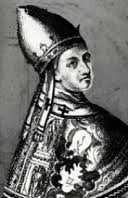
Due to the unprecedented actions of Pope Benedict IX (the only pope currently regarded as having served multiple, non-consecutive terms), Henry III found three different popes in 1046 when he arrived in Rome seeking coronation as Holy Roman emperor.[20] Henry III decided to depose all three and install Pope Clement II (1046–1047).[21]
Holy Roman Empire (1048–1059)
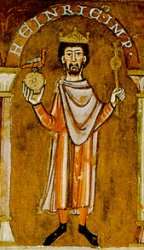
Henry III also installed the three successors to Pope Leo IX (1049–1054), all Germans, without the formality of election.[21] However, the death of Henry III and the rise of child emperor Henry IV, Holy Roman Emperor allowed Pope Nicholas II (1059–1061) to promulgate In Nomine Domini in 1059, ensuring that all future elections (and, eventually, conclaves) would conform to a basic process that has remained largely unchanged for almost a millennium.[21]
Notes
- 1 2 Baumgartner, 2003, p. 3.
- ↑ Titus 1:5
- ↑ Didache, 15.1
- 1 2 3 4 5 6 Baumgartner, 2003, p. 4.
- ↑ Eusebius, Church History, VI.6.29
- 1 2 3 Baumgartner, 2003, p. 5.
- 1 2 3 Baumgartner, 2003, p. 6.
- 1 2 3 Baumgartner, 2003, p. 7.
- 1 2 3 Baumgartner, 2003, p. 8.
- 1 2 3 4 Baumgartner, 2003, p. 9.
- 1 2 3 4 5 6 Baumgartner, 2003, p. 10.
- 1 2 3 4 Baumgartner, 2003, p. 11.
- 1 2 Ekonomou, 2007, p. 215.
- ↑ Ekonomou, 2007, p. 216.
- 1 2 3 4 5 Baumgartner, 2003, p. 12.
- 1 2 3 Baumgartner, 2003, p. 13.
- 1 2 3 4 5 Baumgartner, 2003, p. 14.
- 1 2 3 Baumgartner, 2003, p. 15.
- 1 2 3 Baumgartner, 2003, p. 16.
- 1 2 3 4 5 6 Baumgartner, 2003, p. 17.
- 1 2 3 Baumgartner, 2003, p. 18.
References
- Baumgartner, Frederic J. (2003). "Behind Locked Doors: A History of the Papal Elections". Palgrave Macmillan. ISBN 0-312-29463-8.
- Ekonomou, Andrew J. (2007). Byzantine Rome and the Greek Popes: Eastern influences on Rome and the papacy from Gregory the Great to Zacharias, A.D. 590–752. Lexington Books.

